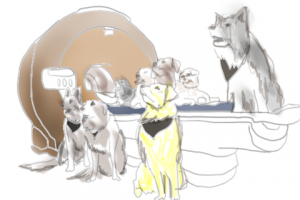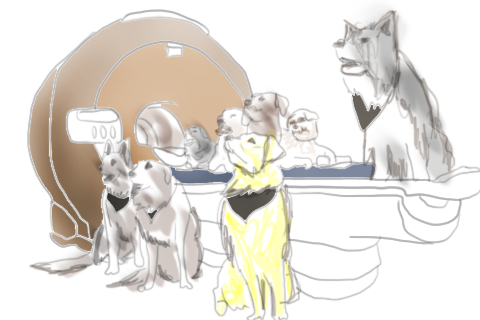This post is also available in Dutch.
We talk to our pets all the time, and intonation is a key element when communicating to them. Is it only intonation or are the words also important for your pet?

Picture made by Roselyne
Many of us have an elderly relative who claims that his or her dog is exceptionally smart; that they can even understand their owner’s speech! Guess what? There is some truth to that according to Science magazine. Just like humans, dogs use their left hemisphere to process meaningful words; whereas, the right hemisphere analyzes intonation independently. This suggests that the brain of a dog can separate what you say from how you say it.
The social animal
Dogs that participated in the above mentioned fMRI study listened to the recordings of a woman trainer that spoke commands with different intonations. Both meaningful (“Good boy! Well done!”) and meaningless (“however”, “even if”) utterances were said with positive or neutral intonation. Interestingly, the reward center was activated only when a dog was praised using both positive intonation and meaningful words. Usually the reward center fires up when the animal is pet or receives food. It turns out that rewarding words can produce the same effect as pleasant actions or objects. It may be that dogs pay attention to both what humans are saying and how they do it because only this unique combination brings positive things: a bit of belly scratching or a tasty bone. Dogs don’t only tune in to human speech but to human faces as well. In another fMRI study scientists showed pictures of objects and different human facial expressions to dogs laying inside the scanner. The brain activity of a dog looking at the pictures of humans was similar to the brain activity of a human looking at images of people’s facial expressions. This does not mean that dogs and humans perceive human faces in the same way. It means that human faces are informative for dogs. This is pretty special, considering that many species can “read” their own species, but dogs can read humans as well. However, it may be that not only dogs but other species are able to “tune in” to humans as well.
It looks like you get me…but you don’t
Scientists propose that neural mechanisms of word processing in dogs and humans are very much alike. We both can combine both the meaning of a word and intonation, as well as separate them. Does this mean that there is nothing special in the “exclusively human” capacity to process word meaning? Not necessarily. Humans and dogs have similar activation patterns in their brains to words, but it does not mean that dogs can comprehend words in the same way. It is also now more clear that the left hemisphere responsible for language in humans, has a broader and more ancient function in dogs. It binds the conventional sequence of sounds to word meaning. Therefore, the capacity to process words is not a feature unique only to humans, but the invention to use words is.
What do dogs get while listening to the human speech? We don’t know that yet, but they definitely process what you say in a human-like way: how you say it and the facial expression with which you say it with. So for now, watch what you say to your dog!
Written by Lara
Edited by Marpessa
